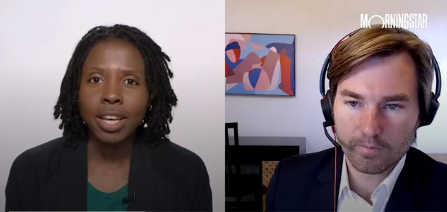Stubborn inflation, a strong jobs markets, the debt ceiling debate and 10 straight interest-rate hikes are creating a lot of uncertainty. Senior multimedia editor Ivanna Hampton questions Morningstar Research Services’ senior U.S. economist Preston Caldwell.

Inflation is set at just over 4% in March from a year ago. Talk about where it looks like it’s headed.
Inflation in 2022 for the full year was just over 6%. That was the highest level in over 40 years. But we are optimistic that inflation is coming back down to normal. We think by the end of this year, it should be within range of the Fed’s 2% target.
That’s because most of the high sources of inflation in the past are abating. Supply chain disruptions in energy and food and durable goods and other areas are actually starting to work in the reverse direction. And that’s providing and will continue to provide a lot of deflationary pressure.
The Federal Reserve has raised interest rates 10 times in a row to fight inflation. Are we headed towards a pause?
We do think there’s going to be a pause.
Some have speculated whether the Fed could start cutting rates very soon because of what’s going on in the banking sector. We don’t think that’s going to happen. But we do think that by the end of this year, as inflation gets under control, the Fed will start to cut rates around December of this year in order to get the economy moving again. And then we expect those rate cuts to proceed aggressively in 2024 and 2025 with the federal-funds rate coming ultimately down below 2% compared with about 5% today.
The April jobs report exceeded expectations. Can you describe what’s happening in the jobs market?
It’s a bit of a paradox right now because the rate of economic growth has been slowing and jobs growth has been slowing as well, but not as much as one would’ve expected.
Over the last year, we’ve seen job growth outpace growth in real GDP, and that’s abnormal. Normally, we have GDP growth slightly ahead of job growth, with the difference between the two being productivity. So employers are still in this mode of rapid hiring that they were early on in the pandemic recovery. But that’s going to change ultimately because if employers don’t shift gears and reduce their hiring, it will start to cut into profits. So we do expect job growth to slow over the course of this year.
Could you give a brief explainer of what the debt ceiling is and how it works?
It’s a procedural quirk. When Congress enacts plans to spend money, it doesn’t automatically authorize the debt needed to pay for that spending in excess of revenue. So instead, a separate process has to occur where Congress periodically raises the limit on total U.S. debt outstanding. And for a long time, historically, this procedural quirk didn’t cause much issue. It was neglected as an area of concern. But it’s become a tool for partisan squabbling in recent decades, and the culpability goes to both sides of the political spectrum. Right now, we are imminently reaching the debt ceiling today. So there’s a concern that as early as June, the U.S. could brush up against that ceiling. And at that point, we’re not sure exactly what would happen, but the federal government would have to neglect to pay its bills or pay back its creditors. So that’s obviously a major issue of concern for markets given how unprecedented a default on U.S. government obligations would be.
What would be the impact of a debt default?
Frankly, I think nobody knows what the impact would be on markets and the economy if a default actually happened. If the government came to a deal immediately after a default and remediated the situation and made creditors hold, then perhaps markets would just shrug this off as a small technical issue. But there’s a degree of self-fulfilling prophecy in terms of how bond markets assess the credibility, the creditworthiness of government debt. And so if this leads to a long-term loss in confidence in U.S. Treasuries, then that has a major deleterious implication for the U.S. economy.
What kind of fallout will the recent bank failures have on the economy?
Right now, it looks like it’s going to be another contributor to slowing economic growth, but not a step change, certainly not a 2008-style scenario. Based off our analysis, including our banking equity research team, we think that the issues that have brought down Silicon Valley Bank and First Republic and the other banks that have failed remain fairly contained. Those are idiosyncratic issues that affected those banks, that, among other things, made their deposit bases especially risky and isn’t a harbinger of broader weakness or broader panic in the banking sector. Indeed, in recent weeks, we’ve seen deposit outflows become quite small, which suggests that the rest of the banking sector is stabilizing.